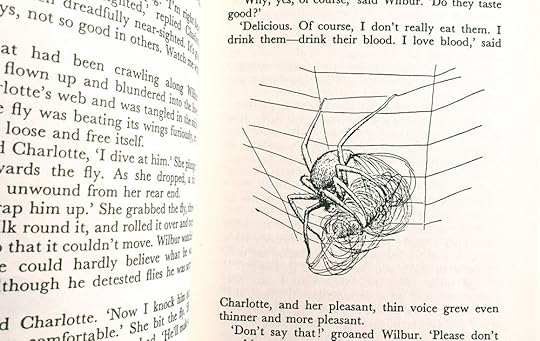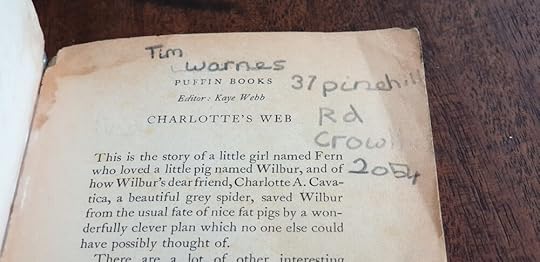Some book: Thankful for a spider named Charlotte

Charlotte’s Web by E.B. White, ill. by Garth Williams. Puffin Books edition, 2002
There’s an intimacy we have with the books we fall in love with as young readers.
— Claudia Bedrick, Publisher: Enchanted Lion
I grew up in a Victorian, red brick house. It had its fair share of spiders.
I’d spot them, scuttling away across the floor. In the bathroom lived the biggest of them all - George. I wasn’t afraid of him. Perhaps because my parents weren’t either. Mum always referred to the tiny ones as ‘money spiders’ and regarded them good omens. Dad affectionately referred to all spiders as George. I was there recently - yes, they still live in my childhood home - and Dad said, ‘Look there’s George!’ I wonder how long he’s been calling spiders, ‘George’? (My dad’s 88 now, and shows no sign of stopping the habit.)
I have a spider in my kitchen, who I refer to affectionately as Charlotte.
Because so ingrained in me is E.B. White’s story, Charlotte’s Web, that it didn’t occur to me to call her anything else. (Not even George!)
Charlotte was here when I first moved in four months ago. I had effectively taken up residence in her space, so I decided to let her be. And sharing my home with a spider has turned out to be a rather rewarding experience.
My Charlotte (like Wilbur the pig’s) is an orb-web spider - and she is absolutely beautiful. Her body is scrawled with lines and squiggles - an arachnid arabesque of great detail. Her long, stripy legs (which like her fictional counterpart’s, are awfully hairy) have a delicate touch.
No wonder Wilbur became entranced by his Charlotte!

© Tim Warnes 2019
Charlotte’s Web is is one of the best-selling children’s books of all time.
‘The tale of how a little girl named Fern, with the help of a friendly spider, saved her pig Wilbur from the usual fate of nice fat little pigs’, has sold more than 45 million copies and has been translated into 23 languages.
Author E.B. White became fascinated with spiders as he undertook the research for his book. ‘I spent a year studying spiders before I ever started writing this book,’ he wrote.
I get it! Observing and sharing my space with Charlotte has been fascinating. She is always to be found in her web, which she spins in front of the french doors (apart from one morning, when I was surprised to discover her on top of the teaspoons in my cutlery drawer.)
White studied the textbook, American Spiders by Gertsch as part of his research. Parts of it are quoted in White’s biography, The Story of Charlotte’s Web, including this thought-provoking reflection:
… [The orb web] represents a triumph in engineering worthy of great mechanical ingenuity and learning; yet it was arrived at by lowly spiders …
It’s hard not to marvel at the skill of a spider at work.

Charlotte’s Web by E.B. White, ill. by Garth Williams. Text © E.B. White 1952, renewed 1980. (Hamish Hamilton 1952)
A spider can produce several kinds of thread. She uses a dry, tough thread for foundation lines, and she uses a sticky thread for snare lines - the ones that catch and hold insects. Charlotte decided to use her dry thread for writing the new message.
‘If I write the word TERRIFIC with sticky thread,’ she thought, ‘every bug that comes along will get stuck in it and spoil the effect.’
- Charlotte’s Web by E.B. White

Charlotte’s Web by E.B. White, ill. by Garth Williams. Puffin Books edition, 1972
I own two copies of Charlotte’s Web, considered by many to be a modern classic.
A prized, dog-eared paperback (featuring a still from the Hanna-Barbera animation as the cover illustration); and a more robust hardback that I found recently in a charity shop. Both with delightful pen and ink drawings by Garth Williams.
I have a real attachment to the original paperback. Like an artefact from my childhood, its yellowing pages feel fragile as you turn them. I daren’t open them fully now, as the glue of the spine has become so brittle (the outside is held together with sticky tape). And just inside the cover, on the first page, I have claimed ownership and carefully written my name, address and phone number.
As I remember, I erased my brother’s name first and replaced it with mine. It’s hard to tell now.
Either way, the point is - I took ownership of Charlotte’s Web. We would be forever bonded.
Or does it own me?
I often return to Charlotte’s Web and Zuckerman’s farm, picking it up from time to time to read a passage or two. (I recently downloaded the excellent audio version, read by E.B. White himself. His narration was suitably relaxed and authentic, and the way he phrased things lent new meaning to some of the dialogue). I remember being read it as a child and have enjoyed reading it with my sons, too. Disappointingly, they didn’t make the same connection as me (disappointing because I wanted them to find the same level of joy in it as I do).

Charlotte’s Web by E.B. White, ill. by Garth Williams. Puffin Books edition, 1972
In the autumn, I went for an early morning walk through the meadow.
Walking across grass, wet with dew, always makes me think of these lines from Charlotte’s Web:
The grass was wet and the earth smelled of springtime. Fern’s sneakers were sopping by the time she caught up with her father.
It was 07.30, calm and ethereal, with the low light reflecting off the morning dew. Hundreds of spider webs - orb webs - decorated the grasses. They looked so delicate, so dazzling - yet they are so deathly (to some, at least). In places, the spider had pulled the line taught, causing the grass heads to bend under the tension. And running between them all were single, silver, gossamer threads. A few of the webs were torn like laddered tights. But most were complete and whole and so, so beautiful. It was magical.
As well as spiders and dewy grass, the excitement of a fairground on a summer’s evening (where the climactic scenes of Charlotte’s Web are played out) also takes me back to the book:
After the heat of the day, the evening came as a welcome relief to all. The Ferris wheel was lighted now. It went round and round in the sky and seemed twice as high as by day. There were lights on the midway, and you could hear the crackle of the gambling machines and the music of the merry-go-round and the voice of the man in the beano booth calling numbers.
Why is this important? Who cares about my recollection of a childhood favourite? What’s your take away, here?
Because it reveals how stories enrich our lives - and how they can help us make sense of it.
‘As a piece of work [Charlotte’s Web] is just about perfect, and just about magical in the way it is done …’, wrote the (wonderfully named) critic, Eudora Welty in the New York Times in 1952. And I agree. It’s hard to find fault with Charlotte’s Web, and I’m thankful that I was introduced to it at a young age.
So with that, and the holiday seasons - Thanksgiving and Christmas - in mind, what book (a favourite of yours) could you gift and introduce a young person to, before the year is out?
Maybe they’ll connect with it on a deep level, too. It might become entwined with them and you, as my parents are with some books that are important to me.
I’m certainly grateful that Charlotte A. Cavatica wove her magic into the very depths of me.

Charlotte’s Web by E.B. White, ill. by Garth Williams. Text © E.B. White 1952, renewed 1980. (Hamish Hamilton 1952)
Charlotte’s Web is about friendship. it is also about the unavoidable cycle of life and death.
And sadly, as autumn creeps into winter, I sense that my Charlotte’s life, like her fictional counterpart’s, is coming to an end.
She looks rather swollen and seems listless, as Wilbur noted about his friend.
She is in demise.
Sitting there, hunched up in her corner. Very occasionally, I spot her tending to the web. But Charlotte is very slow now; her work on the web half-hearted.
‘Dada - she hasn’t moved for weeks.’
‘I know. I think she’s dying.’ There was a hint of sadness in my voice.
‘Maybe she’s just a very good actor!’ Levi replied cheerily.
‘Good-bye!’ [Charlotte] whispered. Then she summoned all her strength and waved one of her front legs at [Wilbur].
She never moved again.
Charlotte’s Web by E.B. White

© Tim Warnes 2019
Sources
Picture-book Publisher by Kristen Strezo (Harvard Magazine Jan - Feb 2014)
The Story of Charlotte’s Web: E.B. White’s Eccentric Life in Nature and the Birth of an American Classic by Michael Sims (Bloomsbury 2011)
Charlotte’s Web by E.B. White, ill. by Garth Williams (Hamish Hamilton 1952)
Along Came a Spider by Eudora Welty (New York Times, 19 October 1952)
My Life in Books
For lovers of kid lit, this memoir - My Life in Books - is intended to give you the confidence and encouragement to share your own passion; to help you make lasting connections through kids’ books.
Originally posted at www.timwarnes.com ...more
- Tim Warnes's profile
- 30 followers



